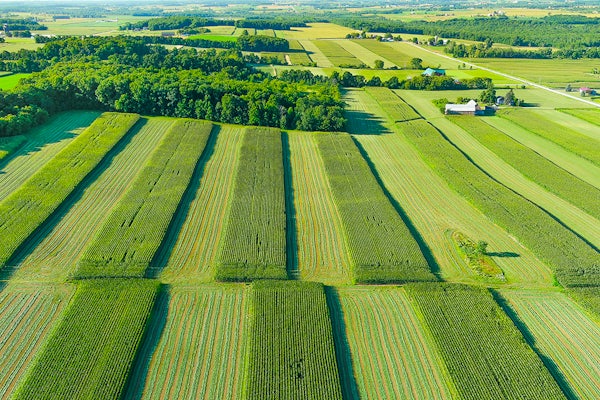Mitigating environmental impact of herbicides
Kimberly Parker, Brent Williams, graduate student Stephen Sharkey evaluate herbicide drift

In recent years, soybean fields and other crops and trees across the Midwest have been experiencing more damage from drift of herbicides, particularly those plants grown from seeds that have not been genetically modified to be herbicide-tolerant. The drift onto unintended plants causes leaves to curl and shrivel and may permanently damage a crop.
To learn more about how the different chemical agents interact in herbicide formulations, a team of researchers in the McKelvey School of Engineering at Washington University in St. Louis is developing a framework to understand how the pieces come together, said Kimberly M. Parker, assistant professor of energy, environmental & chemical engineering. Her collaborators in this work are Stephen M. Sharkey, a fourth-year doctoral student in Parker’s lab, and Brent J. Williams, associate professor of energy, environmental & chemical engineering. Their outlook was published in Environmental Science & Technology Nov. 23, 2021.
In 2020, about 90% of all corn, cotton and soybeans planted in the United States were genetically modified to tolerate one or more herbicides, such as glyphosate, dicamba or 2,4-dichlorophenoxyacetic acid (2,4-D). As a result, the associated herbicides for the tolerant crops have typically seen increased use, Sharkey found. In 2014-2015 before the release of dicamba-tolerant crops, dicamba was used on 2% of all U.S. soybeans, while in 2017-2018 after the release of dicamba-tolerant crops, it was used on 21% of all U.S. soybeans.
The herbicides dicamba and 2,4-D affect other nontargeted plants unintentionally via herbicide drift, either as primary or secondary drift. Primary drift typically occurs shortly after application as sprayed droplets containing herbicide molecules are carried to off-target crops by the wind. Secondary drift occurs over longer time periods when the herbicide converts from a liquid or solid state into a vapor, then drifts away from the targeted crops influenced by air temperature, wind, moisture and herbicide formulation. This change into a vapor state, known as volatilization, may be made worse when dicamba and 2,4-D are applied to herbicide-tolerant crops later in the season because of higher temperatures and because plants are larger and cover the soil.
While there are regulations in place on when and how to spray these herbicides, drift remains a problem and has spurred a bevy of lawsuits in recent years. Due to these lawsuits, several dicamba products were removed from use and required re-approval by the U.S. Environmental Protection Agency (EPA).
Dicamba contains an amine, a chemical agent intended to keep the herbicide in place instead of volatilizing into the atmosphere.
“We want to try to figure out why these formulations have different volatility levels,” said Sharkey, who has previously published a paper on amines in dicamba formulations. “Our focus has been on the amines that are included in dicamba formulations and how the amines’ chemical properties influence dicamba’s volatility.”
In addition, their review analyzed the extent to which herbicide use is tied to genetically modified crop introduction. They found that the introduction of herbicide-tolerant crops does influence the use rates and practices of herbicides. While the newer products including dicamba and 2,4-D have reduced the sole reliance on glyphosate, dicamba and 2,4-D have been used more frequently since crops designed to tolerate them were brought to the market. In just one year, from 2016 to 2017, the use of dicamba increased by a factor of 2.3 after dicamba-resistant crops were introduced in 2015.
Sharkey also sifted through data on the different herbicide products and the regulations and deregulations about how they are to be applied. The EPA limits the use of dicamba and 2,4-D to reduce drift, but those regulations for soybeans and corn have been relatively unchanged since 2014. Other requirements intended to reduce the drive includes restricting the types of nozzle used when spraying the herbicides as well as a required buffer area.
“To address these challenges posed by herbicide drift, continued progress is needed to improve practices that prevent drift, including the design of chemical formations and to understand the impact of herbicides after they enter the atmosphere,” Parker said. “By defining factors that contribute to herbicide drift and characterizing the atmospheric processes that influence its impact, we may develop new solutions to prevent it.”
Sharkey SM, Williams BJ, Parker KM. Herbicide Drift from Genetically Engineered Herbicide-Tolerant Crops. Environmental Science & Technology, Nov. 23, 2021. https://doi.org/10.1021/acs.est.1c01906
This research was funded by the National Science Foundation (CBET-2046602).





